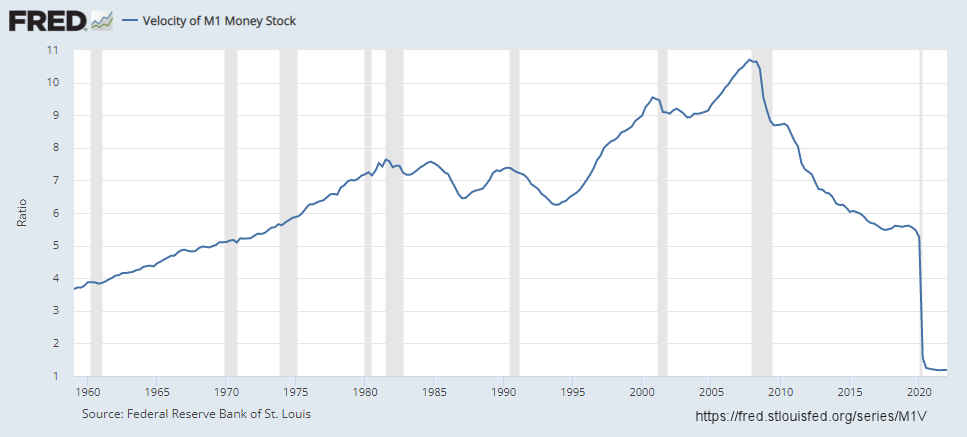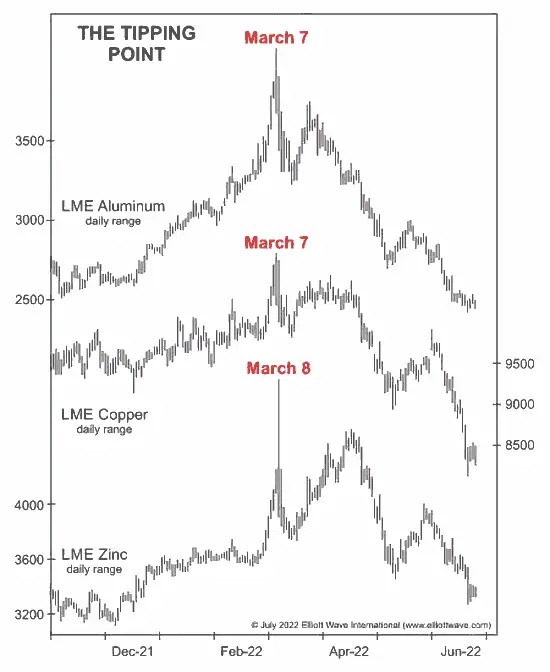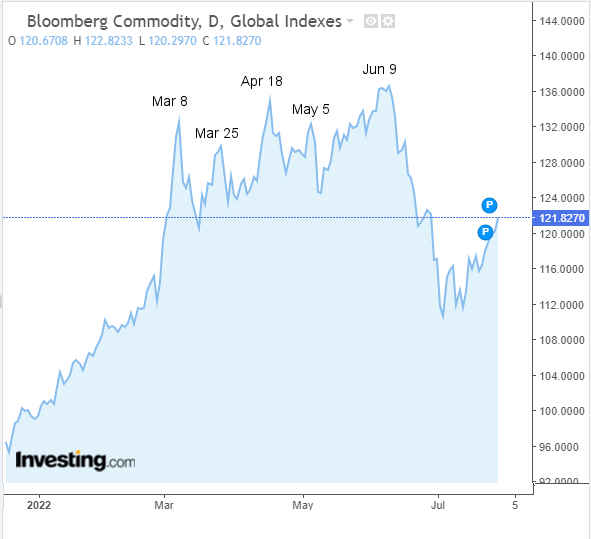A recent article from Elliottwave International suggests the possibility that Aluminum, Copper and Zinc may have peaked on March 7-8th. They included the following chart…
And the following commentary:
The Goldman Sachs Spot Commodity Index hit a high on March 8, and so did the Bloomberg Commodity Index. Crude oil futures made an intraday high on March 7 and a closing high on March 8. Platinum reached a closing high on March 7.
Commodity prices are leading indicators of overall inflation since they are components of every consumer good. Another major component affecting all other prices is gasoline and oil. According to AAA, regarding the price of gasoline… National Average Falls, But Rebounding Gas Demand and Crude Prices May Change Its Course.
Looking at the Bloomberg Commodity index chart, we do see a peak on March 8th followed by a lower peak on March 25th. But then we see a higher peak on April 18th followed by a lower peak on May 5th. Then on June 9th we saw a final peak followed by a massive decline. Currently, prices seem to be rebounding but now they are facing the resistance of all the previous lows since March 8th. It is quite possible that we will see a test of the low right after the May 5th peak and then a decline from there. If so it could mean that inflation is moderating.
Falling Prices = Falling Demand = Recession?
Falling prices could be the result of increased supply or it could indicate that demand for commodities is falling due to a weakening economy. That could mean we are on the verge of a recession. One definition of a recession is two consecutive quarters of declining GDP, and we now have that, but the Biden administration is objecting to that definition because unemployment is so low. In the past, here at InflationData, we have relied on the National Bureau of Economic Research (NBER) to determine the official start a finish of a recession, and they do include unemployment in their calculations. They are also always “behind the curve” in announcing their determination simply because they can’t know when a peak has occurred until after it has happened. So the two-quarters of decline is more of a leading indicator, while the NBER’s official pronouncement of a “top” or bottom always occurs months after the fact.
As we recently said in our updated article on the money multiplier, the current inflation situation is certainly different. As we can see in the following chart from the velocity of money (VOM) article, VOM is at historically low levels. This typically doesn’t occur during inflationary periods. Typically as inflation heats up, people rush to spend it before it becomes worthless or at least worth less. But during recessions, people hold onto their money for longer. One reason VOM hasn’t accelerated with inflation is that Millennials have Zero experience with inflation and don’t understand how devastating to purchasing power it can be.
 This lack of experience, combined with a more recent experience with a major recession, could be influencing people to hoard money (i.e. curtail spending) rather than spend faster to avoid inflation’s effects. In other words, people may currently fear recession more than they fear inflation. It is quite possible that they will get both as we saw with the 1970s “stagflation“. As we said in the Stagflation article,
This lack of experience, combined with a more recent experience with a major recession, could be influencing people to hoard money (i.e. curtail spending) rather than spend faster to avoid inflation’s effects. In other words, people may currently fear recession more than they fear inflation. It is quite possible that they will get both as we saw with the 1970s “stagflation“. As we said in the Stagflation article,
“The major problem with stagflation is that the normal methods of increasing interest rates doesn’t help the situation. The only reason it helps in times of high economic activity is because it slows the “velocity of money” or the speed at which it changes hands.”
But as we saw above, the velocity of money is already at “rock bottom,” so raising interest rates may not help. Typically, when the economy is weak the standard medicine administered by the FED is to lower interest rates to stimulate the economy. Unfortunately, it is impossible to stimulate the economy by lowering rates while simultaneously fighting inflation by raising rates.
So, what can the FED do for Stagflation? The only real solution is to face the real problem (which isn’t interest rates at all but the money supply). It has to reduce the money supply to get the economy back on a firm footing.
See: Aluminum, Copper, Zinc: The 3 Horsemen of the Upcoming “Econocalypse” for more information.
See Also:
- What is Stagflation?
- Millennials Have Never Seen Inflation This High
- What is the Money Multiplier?
- What is the Velocity of money?




Leave a Reply